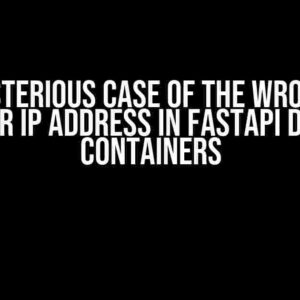Are you stuck in the Docker conundrum, where you can’t seem to override the entrypoint or CMD from a specific image? Fear not, dear developer, for we’re about to embark on a journey to unravel this mystery and uncover the secrets to taking control of your containerized applications.
The Problem Statement
You’ve pulled a container image from a registry, and you’re stuck with the default entrypoint or CMD. You’ve tried using the --entrypoint flag, modifying the Dockerfile, or even resorting to dark magic, but nothing seems to work. The frustration is palpable, and you’re left wondering if you’re the only one facing this issue.
Understanding Entrypoint and CMD
Before we dive into the solution, let’s take a step back and understand what entrypoint and CMD are in the context of Docker.
Entrypoint: An entrypoint is an executable that serves as the default command to execute when a container is started. It’s specified in the Dockerfile using the ENTRYPOINT instruction. Think of it as the default program that runs when you launch the container.
CMD: CMD, on the other hand, is a default command that can be overridden by the user when running the container. It’s specified in the Dockerfile using the CMD instruction. CMD is used to provide a default command that can be overridden by the user.
The Culprit: Immutable Docker Images
So, why can’t you override the entrypoint or CMD from a specific image? The culprit lies in the very nature of Docker images: immutability. Docker images are designed to be immutable, meaning that once an image is built, its contents cannot be modified. This ensures that the image remains consistent across different environments and deployments.
When you pull an image from a registry, you’re getting a snapshot of the image at a particular point in time. Any changes you make to the image, including modifying the entrypoint or CMD, would essentially create a new image. This is where things get tricky.
Solution 1: Create a New Image with a Custom Entrypoint or CMD
One way to overcome the immutability hurdle is to create a new image with a custom entrypoint or CMD. You can do this by creating a new Dockerfile that inherits from the original image and modifies the entrypoint or CMD accordingly.
Here’s an example:
FROM original-image:latest ENTRYPOINT ["my-custom-entrypoint"]
In this example, we’re creating a new image that inherits from the original image and sets a custom entrypoint. You can then build the new image using the docker build command.
Solution 2: Use a Dockerfile with an Overlay
Another approach is to use a Dockerfile with an overlay. This involves creating a new Dockerfile that overlays the original image with a custom entrypoint or CMD.
Here’s an example:
FROM original-image:latest as base FROM scratch COPY --from=base / / ENTRYPOINT ["my-custom-entrypoint"]
In this example, we’re creating a new Dockerfile that overlays the original image with a custom entrypoint. The --from=base syntax tells Docker to copy the contents of the original image into the new image.
Solution 3: Use a Script to Override the Entrypoint or CMD
What if you can’t modify the original image or create a new one? Fear not, for there’s a third solution that involves using a script to override the entrypoint or CMD.
Here’s an example:
docker run -it --entrypoint=my-custom-entrypoint original-image:latest
In this example, we’re using the --entrypoint flag to override the default entrypoint of the original image with a custom script.
Best Practices and Gotchas
Now that we’ve explored the solutions, let’s discuss some best practices and gotchas to keep in mind:
- Be mindful of image layers: When creating a new image with a custom entrypoint or CMD, be aware of the layering system. Avoid adding unnecessary layers that can bloat the image size.
- Use meaningful names: When creating a new image, use meaningful names that indicate the customizations made. This helps with tracking and debugging.
- Test thoroughly: Test your custom images thoroughly to ensure they work as expected in different environments.
- Avoid overriding system commands: Be cautious when overriding system commands, as it may lead to unintended consequences.
Conclusion
In conclusion, overriding the entrypoint or CMD from a specific image may seem like a daunting task, but with the right techniques and understanding of Docker’s immutability, you can take control of your containerized applications.
Remember, creating a new image with a custom entrypoint or CMD, using a Dockerfile with an overlay, or employing a script to override the entrypoint or CMD are all viable solutions. By following best practices and being mindful of gotchas, you’ll be well on your way to Docker mastery.
| Solution | Description |
|---|---|
| Create a new image with a custom entrypoint or CMD | Modify the original image by creating a new Dockerfile that inherits from the original image and sets a custom entrypoint or CMD. |
| Use a Dockerfile with an overlay | Create a new Dockerfile that overlays the original image with a custom entrypoint or CMD. |
| Use a script to override the entrypoint or CMD | Employ a script to override the default entrypoint or CMD of the original image using the --entrypoint flag. |
Now, go forth and conquer the world of Docker!
Frequently Asked Question
Stuck with overriding the entrypoint or CMD from a specific image? Don’t worry, we’ve got you covered! Here are some frequently asked questions and answers to help you out.
Why can’t I override the default entrypoint or CMD when running a specific image?
When you run a specific image, Docker uses the default entrypoint or CMD specified in the image’s Dockerfile. If you want to override these defaults, you need to use the `–entrypoint` or `-c` flag when running the container. For example, `docker run -it –entrypoint /bin/bash my-image` would override the default entrypoint with `/bin/bash`.
How do I override the CMD instruction in a Dockerfile?
You can override the CMD instruction by providing a command when running the container. For example, `docker run my-image /bin/bash` would override the default CMD with `/bin/bash`. You can also use the `-c` flag to specify a command, like this: `docker run -c “echo ‘Hello World!'” my-image`.
What is the difference between an entrypoint and a command in a Dockerfile?
In a Dockerfile, the `ENTRYPOINT` instruction specifies the default executable that should be used when running the container. The `CMD` instruction specifies the default arguments that should be passed to the entrypoint. Think of it like this: the entrypoint is the command, and the CMD is the argument. You can override either or both of these defaults when running the container.
Can I override the entrypoint or CMD for a specific container instance?
Yes! When running a container, you can override the default entrypoint or CMD using the `–entrypoint` or `-c` flag. These overrides only apply to the specific container instance, and do not change the defaults for the image.
What happens if I override the entrypoint or CMD and the image has a default?
When you override the entrypoint or CMD, the default values specified in the image’s Dockerfile are ignored. The overridden values take precedence, and are used when running the container.


